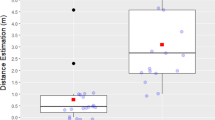Abstract
We have proposed a system that superimposes auxiliary figures on a VR scene according to viewer’s physiological signals that are responses to the viewer’s VR sickness, in order to reduce VR sickness but not interfere with viewer's sense of immersion. We conducted an experiment to find a type of physiological signals that correlated strongly with VR sickness. The results showed that sweating on a viewer’s hand was strongly correlated, and that the amount of sweating tended to increase as the VR sickness worsened. Then, we designed and developed the proposed system that controlled degree of alpha blending of color of Dots as an auxiliary figure that reduces VR sickness according to amount of the sweating and conducted an experiment to evaluate it. The results showed that the effect of the system to reduce VR sickness was found to be effective for the participants with less VR experience although there was no statistically significant difference among the experimental conditions. Additionally, the results also showed that the controlled presentation of the system was less distracting on immersion of a VR scene than the constant presentation as a previous system.
Access this chapter
Tax calculation will be finalised at checkout
Purchases are for personal use only
Similar content being viewed by others
References
Jerald, J.: The VR book: human-centered design for virtual reality. In: Association for Computing Machinery and Morgan & Claypool (2015)
Brainard, A., Gresham, C.: Prevention and treatment of motion sickness. Am. Fam. Phys. 90(1), 41–46 (2014)
Kariya, A., Wada, T., Tsukamoto, K.: Study on VR sickness by virtual reality snowboard. Trans. Virtual Reality Soc. Japan 11(2), 331–338 (2006)
Hashilus Co, Ltd.: Business description. https://hashilus.com/business/. Last accessed 2022/01/20
Aoyama, K., Higuchi, D., Sakurai, K., Maeda, T., Ando, H.: GVS RIDE: providing a novel experience using a head mounted display and four-pole galvanic vestibular stimulation. In ACM SIGGRAPH 2017 Emerging Technologies (SIGGRAPH’17), Article 9, pp. 1–2. Association for Computing Machinery, New York, NY, USA (2017)
Sra, M., Jain, A., Maes, P.: Adding proprioceptive feedback to virtual reality experiences using galvanic vestibular stimulation. In: Proceedings of the 2019 CHI Conference on Human Factors in Computing Systems (CHI’19), Paper 675, pp, 1–14. Association for Computing Machinery, New York, NY, USA (2019)
Omata, M., Shimizu, A.: A proposal for discreet auxiliary figures for reducing VR sickness and for not obstructing FOV. In: Proceedings of the 18th IFIP TC 13 International Conference on Human-Computer Interaction, INTERACT 2021, Sequence number 7. Springer International Publishing (2021)
Bos, J.E., MacKinnon, S.N., Patterson, A.: Motion sickness symptoms in a ship motion simulator: effects of inside, outside, and no view. Aviat. Space Environ. Med. 76(12), 1111–1118 (2005)
Norouzi, N., Bruder, G., Welch, G.: Assessing vignetting as a means to reduce VR sickness during amplified head rotations. In: Proceedings of the 15th ACM Symposium on Applied Perception (SAP’18), Article 19, pp. 1–8. Association for Computing Machinery, New York, NY, USA (2018)
Duh, H.B., Parker, D.E., Furness, T.A.: An “independent visual background” reduced balance disturbance envoked by visual scene motion: implication for alleviating simulator sickness. In: Proceedings of the SIGCHI Conference on Human Factors in Computing Systems (CHI’01), pp. 85–89. Association for Computing Machinery, New York, NY, USA (2001)
Sargunam, S.P., Ragan, E.D.: Evaluating joystick control for view rotation in virtual reality with continuous turning, discrete turning, and field-of-view reduction. In: Proceedings of the 3rd International Workshop on Interactive and Spatial Computing (IWISC’18), pp. 74–79. Association for Computing Machinery, New York, NY, USA (2018)
Fernandes, A.S., Feiner, S.K.: Combating VR sickness through subtle dynamic field-of-view modification. In: 2016 IEEE Symposium on 3D User Interfaces (3DUI), pp. 201–210 (2016)
Budhiraja, P., Miller, M.R., Modi, A.K., Forsyth, D.: Rotation blurring: use of artificial blurring to reduce cybersickness in virtual reality first person shooters. arXiv:1710.02599[cs.HC] (2017)
Whittinghill, D.M., Ziegler, B., Moore, J., Case, T.: Nasum Virtualis: a simple technique for reducing simulator sickness. In: Proceedings of Games Developers Conference (GDC), 74 (2015)
Cao, Z., Jerald, J., Kopper, R.: Visually-induced motion sickness reduction via static and dynamic rest frames. In: IEEE Conference on Virtual Reality and 3D User Interfaces (VR), pp. 105–112 (2018)
Buhler, H., Misztal, S., Schild, J.: Reducing VR sickness through peripheral visual effects. In: IEEE Conference on Virtual Reality and 3D User Interfaces (VR), pp. 517–519 (2018)
Ishihara, N., Yanaka, S., Kosaka, T.: Proposal of detection device of motion sickness using nose surface temperature. In: Proceedings of the Entertainment Computing Symposium 2015, pp. 274–277. Information Processing Society of Japan (2015)
Narens, L.: A theory of ratio magnitude estimation. J. Math. Psychol. 40(2), 109–129 (1996)
Thought Technology Ltd.: ProComp infiniti system. https://thoughttechnology.com/procomp-infiniti-system-w-biograph-infiniti-software-t7500m. Last accessed 2022/01/20.
Unity Asset Store.: https://assetstore.unity.com/. Last accessed 2022/01/20.
Stevens, S.S.: On the psychophysical law. Psychol. Rev. 64(3), 153–181 (1957)
Kennedy, R.S., Lane, N.E., Berbaum, K.S., Lilienthal, M.G.: Simulator sickness questionnaire: an enhanced method for quantifying simulator sickness. Int. J. Aviat. Psychol. 3(3), 203–220 (1993)
IJsselsteijn, W.A., de Kort, Y.A.W., Poels, K.: The game experience questionnaire. Technische Universiteit Eindhoven. Eindhoven (2013)
Author information
Authors and Affiliations
Corresponding author
Editor information
Editors and Affiliations
Rights and permissions
Copyright information
© 2023 The Author(s), under exclusive license to Springer Nature Singapore Pte Ltd.
About this paper
Cite this paper
Omata, M., Suzuki, M. (2023). Auxiliary Figure Presentation Associated with Sweating on a Viewer’s Hand in Order to Reduce VR Sickness. In: Nakamatsu, K., Patnaik, S., Kountchev, R., Li, R., Aharari, A. (eds) Advanced Intelligent Virtual Reality Technologies. Smart Innovation, Systems and Technologies, vol 330. Springer, Singapore. https://doi.org/10.1007/978-981-19-7742-8_8
Download citation
DOI: https://doi.org/10.1007/978-981-19-7742-8_8
Published:
Publisher Name: Springer, Singapore
Print ISBN: 978-981-19-7741-1
Online ISBN: 978-981-19-7742-8
eBook Packages: Intelligent Technologies and RoboticsIntelligent Technologies and Robotics (R0)




